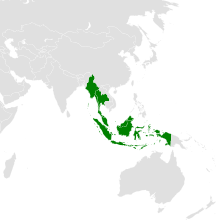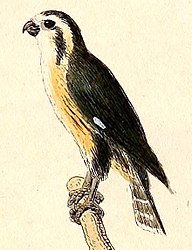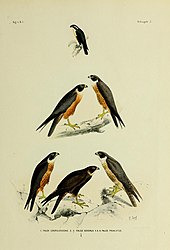Finkenfälkchen
| Finkenfälkchen | ||||||||||||
|---|---|---|---|---|---|---|---|---|---|---|---|---|

Finkenfälkchen |
||||||||||||
| Systematics | ||||||||||||
|
||||||||||||
| Scientific name | ||||||||||||
| Microhierax fringillarius | ||||||||||||
| ( Drapiez , 1824) |

The finch falcon ( Microhierax fringillarius ) lives in Southeast Asia and is the smallest species of falcon in the world.
Size, description and calls
The finch falcon is only 14 to 17 cm long and has a wingspan of 27 to 34 cm. The weight is 28 to 55 g. The pygmy falcon species also found in Southeast Asia, robin falcon , white-headed falcon , two-colored falcon and magpie falcon, are only slightly larger.
The finch falcon is a strangling falcon with pointed wings and an often splayed, angular tail. The adult male is glossy black on top with a white forehead stripe that curves around black cheeks. It has a white or reddish faded throat with a white chest. Its thighs, flanks and fangs are black. The male has white underwings with black stripes on the primary and secondary feathers. Below the otherwise black tail there are three white bars. The adult female is similar to the adult male, but its tail is longer. The juveniles are similar to the adults, but the white areas of the head are reddish. The voice is a hard and high- pitched scream shiew , which is repeated quickly, and a quick, repetitive scream kli-kli-kli-kli .
Habitat
The typical habitat is the forest , the edge of the forest and wooded open space . The finch falcon is also often found in the vicinity of agricultural areas, villages and in the vicinity of active slash-and-burn operations, as well as on rivers, streams and rice fields. The settlement of slash and burn shows that the species tolerates habitat destruction. It usually lives below 1,500 m.
prey
The hawk feeds primarily on insects, including moths , butterflies , dragonflies , termites, and cicadas . Occasionally small birds and lizards are also beaten. Feeding behavior often appears to be social, with feeding groups comprising up to ten birds. A large part of the prey is captured by a seat attendant during fast flights.
Brood
This species of hawk is usually social and gregarious. It is often found in loose pairs or groups of ten or more falcons. The breeding season of the species varies depending on the location. Populations north of the equator breed mainly between February and June; south of the equator, oviposition is recorded in Java in November and December. The falcons breed mostly in abandoned breeding caves of barbet bird species, occasionally also in old woodpecker caves and in rock holes. Apart from insect remains, there are no other animal remains in the breeding caves. The clutch size is between 2 and 5 eggs. The length of the incubation period until hatching is unknown. The nesting hole can be used by adult birds as a sleeping place all year round.
Distribution and population
The finch mackerel breeds in Brunei , Myanmar , Thailand , Malaysia , Singapore and Indonesia . It occurs as a migratory bird in Sri Lanka . The extremely large distribution area covers 1.5 million km². There are no precise data on the stocks. It is believed that the populations, like other small falcons, are underestimated. Estimates of the stocks vary from common (in Sumatra and Borneo ) to fairly common (in Thailand) to rare (in Java and Bali ). The population appears to be in the upper tens of thousands. The stock seems to be stable. There is no evidence of a decline or significant threat. The International Union for Conservation of Nature and Natural Resources (IUCN) classifies the finch falcon in the IUCN Red List of Threatened Species as ![]() (= least concern ) in 2016 .
(= least concern ) in 2016 .
Scientific name
The British scholar Thomas Horsfield described the finch falcon in 1820 at the Linnean Society of London as a subspecies of the European robin falcon ( Microhierax caerulescens , then Falco caerulescens ) from Java . He noted that "the Java specimens are slightly smaller and patterned differently" than the Bengal specimen of the robin falcon described by John Edwards in 1750. A more detailed description was published in Horsfield's 1824 book Zoological researches in Java, and the neighboring islands . Also in 1824 Auguste Drapiez gave the name Falco fringillarius .
Historical illustrations
Almost all historical illustrations were published with the name Falco cærulescens :
- Temminck (1824): Planches Coloriées , plate 97.
- Vieillot & Oudart (1834): Galerie des Oiseaux , plate 18.
literature
- James Ferguson-Lees , David A Christie, Kim Franklin: Raptors of the World. Houghton Mifflin, 2001, ISBN 0-618-12762-3 .
Web links
Individual evidence
- ↑ a b c d e f Ferguson-Lees, Christie, Franklin, Mead & Burton: Raptors of the World Houghton Mifflin 2001. pp. 828-829.
- ↑ a b Handbook of the Birds of the World on the Black-thighed Falconet accessed on February 4, 2018.
- ↑ IUCN Red List of Threatened Species Microhierax fringillarius
- ↑ Thomas Horsfield 1822: Systematic arrangement and description of birds from the island of Java. Section Falco cærulescens . In: Transactions of the Linnean Society of London, Volume 13, page 135 IA BHL
- ^ Horsfield, Thomas (1824). Zoological researches in Java, and the neighboring islands. London: Kingsbury, Parbury, & Allen.
- ↑ Drapiez, Auguste (1824). "Faucon". In Bory de Saint-Vincent. Dictionnaire classique d'histoire naturelle, vol. 6. Paris: Rey & Gravier. P. 412 plate v BHL
- ^ Richard Bowdler Sharpe: Microhierax . Volume I: Catalog of the Accipitres or Diurnal Birds of Prey in the Collection of the British Museum. Catalog of the Birds in the British Museum. London: Trustees of the British Museum. Pp. 366-369.
- ^ R. Bowdler Sharpe: Catalog of the Birds in the British Museum . tape 1 . Taylor and Francis, London 1874, p. 367 ( biodiversitylibrary.org [accessed March 21, 2018]).
- ^ Thomas Horsfield: Zoological researches in Java, and the neighboring islands . Kingsbury, Parbury & Allen, Leadenhall Street 1824, p. 288 ( biodiversitylibrary.org [accessed March 21, 2018]).
- ^ FH von Kittlitz: Copper panels on the natural history of birds . Sauerländer, Frankfurt am Main 1832, p. 41 ( biodiversitylibrary.org [accessed March 21, 2018]).
- ^ H. Schlegel: De vogels van Nederlandsch Indie . Brill, Leiden 1866, p. 217 ( biodiversitylibrary.org [accessed March 21, 2018]).
- ^ CJ Temminck, Meiffren Laugier: Nouveau recueil de planches coloriées d'oiseaux . Baillière, Paris 1824, p. 288 ( Plate 97 online at biodiversitylibrary.org [accessed March 21, 2018]).
- ^ LP Vieillot, MP Oudart: La galerie des oiseaux . Carpentier-Méricourt, Paris 1834, p. 81 , plate 18 ( biodiversitylibrary.org [accessed March 21, 2018]).




